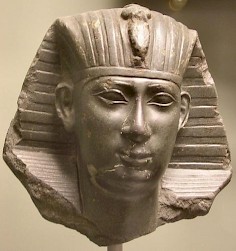Phoenicians, Carthaginians and Libyans, oh my!
Ancient Lebanese, the Phoenicians were one of the world’s first sea explorers (see my journal
The Men Who Drew the Map of the World) and settled the port of Cádiz in the ninth century B.C. They were regarded as the greatest mariners of their time, and the purple cloth they made was highly prized in the ancient world, nowhere more so than wherever royalty sat. No king or queen worth their salt would be seen dead in anything other than purple, so there was a roaring trade in the cloth. So these sailors
par excellence were often commissioned by various rulers to undertake voyages of trade for them, and the evidence suggests that one of these may have taken them to North America.
Halfway up a mountain in New Mexico is an inscription in the Phoenician language which, when translated by scholars in the tongue, turns out to be nothing less than the Ten Commandments from the Bible. The writing has been dated to approximately the ninth century BC again. Seems everyone who was anyone was heading to America in the ninth century BC. And not only North America. Here’s what it says on a stone found on a plantation in Brazil in 1872:
“We are Sidonian Canaanites from the city of the Merchant King. We were cast up on this distant land, a land of mountains. We sacrificed a youth to the celestial gods and goddesses in the nineteenth year of our mighty King Hiram and embarked from Eziongeber into the Red Sea. We voyaged with ten ships and were at sea together for two years around Africa. Then we were separated by the hand of Baal and were no longer with our companions. So we have come here, twelve men and three women, into ‘Island of Iron.’ Am I, the Admiral, a man who would flee? Nay! May the celestial gods and goddesses favor us well!”

(
The Pharaoh Necho: he will not be impressed if you try to dip him in cheese.)
This is believed (by some) to refer to an expedition which set out from Egypt around 600 BC in an attempt to scout for the possibility of digging a canal from the Nile to the Red Sea, ordered by the Pharaoh Necho (no not Nacho) to circumnavigate Africa to see if it could be done. If one of the ships was blown off course and ended up in the land of football, then it’s estimated a date of around 531 BC would fit in. Needless to say, this, like almost every other instance of proof of the presence of civilisation in America before 1492 has been ignored and scorned by most of the scientific community. But the evidence mounts up, m’Lord: in Paraguay there’s a cave with a Phoenician inscription describing a sea voyage.
Coins are another way of proving habitation, and in Kansas, Connecticut, Arkansas and Alabama coins have been found which were clearly minted in the ancient empire of Carthage. The Carthaginians were also known to be great explorers (again, see my journal on exploration) with Hanno, known as “the Navigator”, one of their most famous icons. He himself is not known to have travelled to America - and in fact, there is no record of a Carthaginian expedition sent there - but as Shakira might possibly not say, coins don’t lie, and the ones that have been unearthed have all been dated to the third or fourth century BC. With characteristic stubbornness and a refusal to accept the truth of their own eyes, many scientists have grumbled and insisted that all of these coins must have been - get this - lost by collectors from the modern age.
Yeah. Right. That’s always happening to me. Out walking some farmer’s field in Arkansas with my valuable third century BC coins and don’t a few always slip through that hole in my pocket? Lord give me strength. These are probably the same people who demand to be taken seriously when they proclaim that Jesus was a white man.
Chile is the site of the discovery of writings by ancient Libyans, who claimed Santiago
“for the King of Egypt, for his queen, and for their noble son, running a course of 4,000 miles, steep, mighty, mountainous, on high uplifted. August, day 5 regnal year 16.” Then there’s this, from just down the road in Ecuador:
“The elephant that supports the Earth upon the waters and causes it to quake.” Um, yeah. Guess that long sea voyage had some unexpected side effects on the mariners. The Libyan alphabet and language seems to have found its way into that of Native Americans, particularly the Zuni Indians of southern California, and another inscription is found deep in the heart of Texas that says
“A crew of Shishonq the King took shelter in this place of concealment.” A less stoned crew than the ones in Ecuador, it would seem.

Of course, in matters like this there will always be the hoaxers, the frauds and the outright scammers who, for reasons of their own, want to make it seem as if ancient people visited their state, city or town. I suppose it could help with the tourism anyway, or it could be an effort to make fools out of those who make these claims in other parts of the country. That’s why it’s always advisable to have a genuine clever clogs on board when investigating these finds, and one such, perhaps the cleverest, is also the most reviled by those who believe he is a charlatan, or at best, ignorant.
(Note: when writing this article I got a little turned around, so the references to this guy appear before this introduction, making it a little superfluous, but you're always welcome to suck it. This is hard work. You try doing it!) Professor Barry Fell (no that’s his name, not a statement of an event) is one of the biggest names in the field which has become known as epigraphy, that is, reading and translating, dating and authenticating (or not) ancient inscriptions, be they on cave walls, carved in rock or anywhere else. He has suffered a lot at the hands of the scientific community, many of whom dismiss him as a fraud himself, but in recent times more esteemed figures have begun to take notice of him, and to slowly give credence and respectability to his theories.

He has mixed feelings about artifacts uncovered at a burial site in Davenport, Idaho, which was believed to be a hoax - with someone actually coming forward to take the blame - but which he has reservations (sorry) about. Much of this hinges on the fact that the supposed hoaxer was only nine years old at the time, and even a prodigy would have difficulty faking ancient languages and symbols, to say nothing of how he would have sealed the tablet in the mound and managed to put it all back together without its looking as if it had been disturbed. As well as this, Professor Fell notes there are three different languages on the tablet, and though one of them - Egyptian hieroglyphs - makes no sense, the other two do. However he’s prepared to admit when he gets it wrong, which for me makes him the more believable.
One such occasion took place in Nevada, where a rock he had come to examine looked, to him, as if it had a map of America carved on it. After careful examination though he realised this was just a crack in the natural material of the rock, and the words he had thought referred to the Pacific Ocean were just some ancient prayer, local in origin. This wasn’t actually a hoax or a fraud, just an good illustration of how sometimes simple things could be taken to have greater meaning than they have, and that not every rock with squiggly lines on it is a discovery or proof of the existence of ancient Americans.
And yet, despite these few false trails, the evidence that feet other than those of Native Americans trod the soil of that land goes on, from Quebec and New Hampshire to New York and Pennsylvania, and indeed Fell believes that many of the visitors became permanent residents of America, that the likes of the Libyans and the Iberian Celts settled down, ran schools and farmed, becoming quite possibly the second true Americans after the Indians. There is some evidence of this, but like virtually every other hypothesis he suggest and every theory he advances, it has been met with scorn, derision and alternative explanations. And maybe they’re right; who is to say? After all, we’re dealing here with people who may (or may not) have been here long before the birth of Jesus of Nazareth. That’s a long time back, and the passage of the ages tends to erase any markers left by these people, if they were here.

Fell’s theories do get a little shall we say, out there, though, when he suggests that those Iberian Celts actually set up banks in America (I bet the First Bank of America would have something to say about that!), conclusions he bases on the discovery of, well, here: I’ll let our old mucker Patrick Huyghe explain it in Fell’s words, as I’m tired of typing:
“ He believes the great number of circular designs adorning a series of rock faces at the Castle Garden site near Moneta, Wyoming, represents one such “bank.” The common assumption is that these pictographs and petroglyphs are Indian shield designs. But Fell eventually recognized the petroglyphs as simplified renderings of Roman, Celtic, and Italian bronze coins that were in circulation beginning about 20 b.c. “These pictorial presentations of current coin in ancient America,” Fell explains, “were evidently intended to familiarize the fur trappers and others doing business with the Iberian banks as to the relative values of coins in terms of one another and in terms of skins.
One inscription at the site turned out to be the bank’s shingle. To the left of a central design are Iberic letters spelling the old Gaelic word for “money changer.” On the right is an old Gaelic word that Fell translates as “No usury.” The central illustration uses Greek letters to form a rebus, or design, of an upturned moneybag dropping its coins onto a plate. And the word that these letters spell means “the first to come here.” If you put it all together, says Fell, what you are left with is something on the order of the First National Bank of Iberia in Wyoming.”
I have to say, that sounds more than a little difficult to believe, and I’m sure it was manna from Heaven to his detractors, who would have - possibly metaphorically, possibly literally - pointed and jeered at such notions. I’m kind of tempted to do so myself, but what do I know? You do get the idea though that Professor Fell is seen, among the archaeological community, as a sort of Erich Von Daniken (remember
Chariots of the Gods?) or that guy who’s always appearing on memes and attributing everything to aliens, the most famous (and funny) being “I don’t know therefore aliens.” He gets vilified, with one eminent scientist lambasting his first book as “rubbish” in the
New York Times (I say! Steady on there, old boy!) and others calling him the “Typhoid Mary of popular prehistory.” Ouch.
Maybe they’re just jealous that he gets it and they don’t. Maybe they’re unwilling to admit they might have missed what he discovered. Or maybe they just see him for the fraud they believe he is. I have no idea whether he’s genuine or not, but there certainly is a lot of hostility directed at him. Huyghe however does note that most if not all of this vitriol comes from within Fell's own country, and that in Europe, particularly in Spain, Wales and Ireland, his theories have been supported and applauded. Well now in fairness, they would do wouldn’t they? After all, Fell is making the case for the presence of their people in America long before Columbus, so they’re going to be more likely to support that, as they have a vested interest.
The converse of that though is that the ridicule piled upon Fell by American archaeologists may have its own agenda, may be rooted in the politics and even racism of ensuring that the narrative that has been in place for over five hundred years now remains the only side of the story told, particularly in American schools. The fact that these people refuse to listen to him, laugh at him and do their best to discredit or at best ignore his findings, points to a desire to kowtow to the establishment, ensure Columbus continues to be feted as the discoverer of America, and that a white man retains his historical - if inaccurate, possibly erroneous - position in American history.
Nevertheless, you can only ignore reality for so long, and even deeply-opposed Americans are beginning now to see things Fell’s way, with one Canadian, respected anthropologist David Kelley, championing his cause.